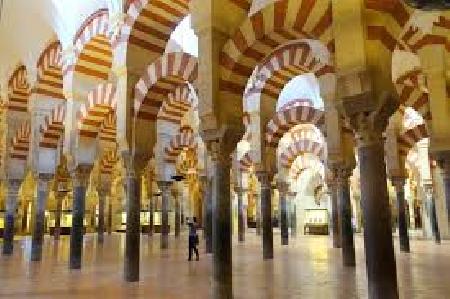Mosque-Cathedral of Córdoba
 The phenomenon of a Muslim mosque, converted from the old Christian church, is well known and widespread, for example, in modern Turkey. Rather, the stories are much stranger, especially the rare cases where a mosque building was converted to a Christian cathedral, and the mosque itself was converted from a Christian temple even earlier. Such is the famous mosque, an incredibly beautiful religious complex in Andalusia, in southern Spain.
The phenomenon of a Muslim mosque, converted from the old Christian church, is well known and widespread, for example, in modern Turkey. Rather, the stories are much stranger, especially the rare cases where a mosque building was converted to a Christian cathedral, and the mosque itself was converted from a Christian temple even earlier. Such is the famous mosque, an incredibly beautiful religious complex in Andalusia, in southern Spain.
The old Spanish city of Córdoba in Andalusia was initially a relatively small settlement (330,000 inhabitants). But it is full of world-class attractions from at least three cultures (Arabic, Jewish, and Spanish) and a mass of tourists. One of Cordoba's main masterpieces is the Mezquita, whose ticket offices can wait an hour or more (unless you buy a ticket online in advance).
In 1031, the Caliphate of Córdoba was divided into small states - or Taifas. Since 1212, Spanish troops gradually began to expel the Arabs, and in 1236 Córdoba came under Christian rule. But for a long time the Muslim population remained here - the so-called Mudejars, who gave the name to the famous artistic style, which was widely used in the mosque. However, in 1492, Catholics expelled Sephardic Jews from Andalusia first and then Muslims.
The Mosque of Córdoba was built on the site of a Visigothic church of San Vicente built around the year 785.
The mosque was expanded and completed with Abdurahman II in 822-825 and with Al-Hakam II in 961-966. The last expansion under the Umayyads occurred under the vizier of al-Mansour in 978.
After Córdoba submitted to Christian rule in 1236, the mosque was consecrated as the Cathedral of the Assumption of Our Lady and began to be decorated with Catholic chapels.
Interestingly, in 2004 Muslims asked to be allowed to officially hold Muslim worship services at the Mosque, but the Vatican did not consent.
The mosque can be said to be a mix of Islamic, Gothic and Moroccan styles.
The Villavisios Chapel was built under the Catholic faith, and the Royal Chapel, where several European monarchs were previously buried (now closed to visitors).
The patio de los naranjos is one of the most beautiful places in the complex where palm trees, citrus and exotic flowers grow.
The tower that rises above the temple complex is an old minaret that, with the advent of Christianity, became an ordinary observation tower. Interestingly, there is now a sculpture of the city's patron, the Archangel Raphael, on top.
Address: Calle Cardenal Herrero, 1, 14003 Córdoba, Spain

